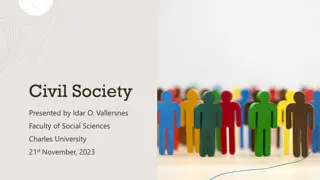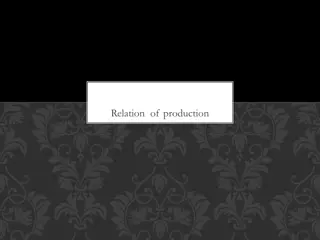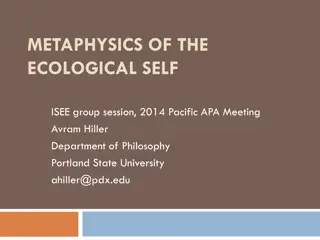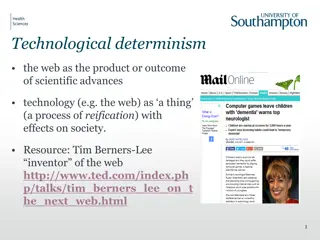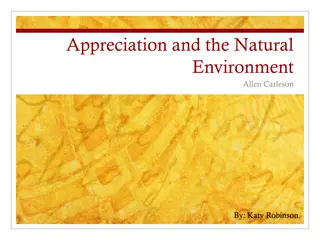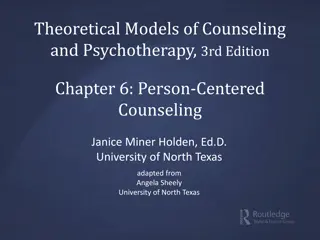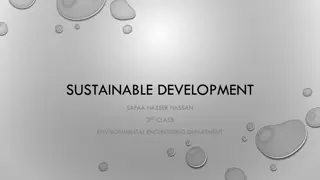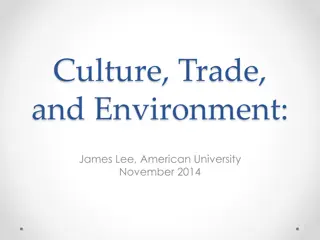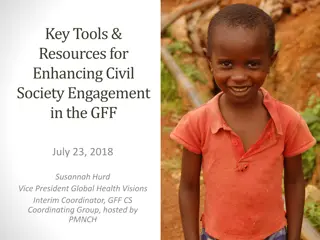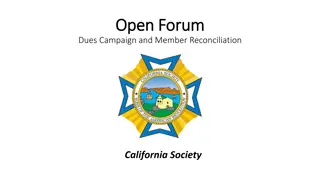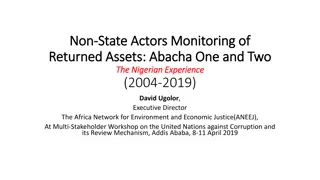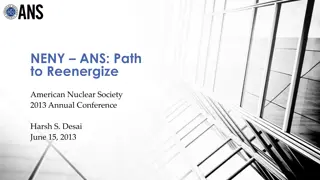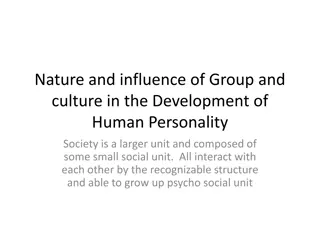Understanding the Interplay Between Society and the Environment
The environment plays a vital role in shaping our lives, and our interactions with society can impact the delicate ecological balance. As our population grows and economic activities intensify, the exploitation of natural resources poses a threat to our environment. From land and forests to water and minerals, each resource serves a crucial function. It is essential to recognize the value of these resources and the need for sustainable practices to ensure a harmonious relationship between society and the environment.
Download Presentation

Please find below an Image/Link to download the presentation.
The content on the website is provided AS IS for your information and personal use only. It may not be sold, licensed, or shared on other websites without obtaining consent from the author. Download presentation by click this link. If you encounter any issues during the download, it is possible that the publisher has removed the file from their server.
E N D
Presentation Transcript
CLASS IX ARTIFICIAL INTELLIGENCE PART A UNIT-5 GREEN SKILLS
INTRODUCTION The environment around us affects all aspects of our life; and all our day-to-day activities also affect the environment. Those who live in cities get their food supply from surrounding villages and in turn, are dependent on forests, grasslands, rivers, seashores, for resources, such as water, fuel wood, fodder, etc. We use resources from which food is made and we depend on the community of living plants and animals, which form a web of life. Everything around us forms our environment and our lives depend on the flora and fauna around us. Similarly, our school environment comprises the physical and the socio-cultural environment.
Society and Environment Society and Environment The interaction of the society with the environment sometimes affects the ecological balance in the environment. With the increase in population and economic activities, people s interference with nature has started destroying the environment. The industrial development and intensive agriculture that provides the goods for our increasingly consumer-oriented society uses up large amounts of natural resources, such as water, minerals, petroleum products, wood, etc. Natural resources A resource can be defined as any natural or artificial substance, energy or organism, which is used by human being for its welfare. These things include water, land, soils, rocks, forests, animals, fossil fuels and minerals. They are called natural resources as they are the basis of life on earth.
Natural resources come in many forms. It may be a solid, liquid or gas. It may also be organic or inorganic. It may also be metallic or non-metallic. (i) Land Resources: Human beings thus, use land as a resource for production as well as residence and recreation. It is a finite resource which is subject to agricultural and non- agricultural uses, such as infrastructure development. (ii) Forest Resources: A forest is a natural, selfsustaining community characterised by vertical structure created by presence of trees. Wood is used for making furniture, tool- handles, railway sleepers, matches, ploughs, bridges, boats, etc. and as a source of energy for cooking purpose and for keeping warm. Tannins, gums, drugs, spices, insecticides, waxes, honey, horns, musk, ivory, hides, etc. are all provided by the flora and fauna of forests. (iii) Water Resources: Water covers about three quarters of Earth s surface and is a necessary element for life. Water resources include rivers, lakes, oceans, and underground aquifers, etc. Water is a vital resource in agriculture, industrial, household and recreational and environmental activities. (iv) Mineral Resources: A mineral deposit is a concentration of naturally occurring solid, liquid, or gaseous material, in or on the Earth s crust in such form and amount that its extraction and its conversion into useful materials or items are profitable now or may be so in the future. Mineral resources are non-renewable and include metals (e.g., iron, copper, and aluminium), and non-metals (e.g., salt, gypsum, clay, sand, phosphates). Some minerals consist of a single element, such as gold, silver, diamond (carbon), and sulphur.
(v) Food Resources: Resources that are used as food, or provide food for organisms are called food resources. Plants serve as food resources for herbivores and omnivores. Animals and birds are the source of food for many organisms who are carnivores and omnivores. Agriculture is the main source of plant food resource for human beings. (vi) Energy Resources: An energy resource is something that can produce heat, power life, move objects, or produce electricity. There are 5 fundamental sources of energy: (i) Nuclear fusion in the Sun (solar energy), (ii) Gravity generated by the Earth and Moon, (iii) Nuclear fission reactions, (iv) Energy in the interior of the Earth, (v) Energy stored in chemical bonds. Most of the energy we use today come from fossil fuels (stored solar energy). But fossils fuels have a disadvantage in that they are non-renewable on a human time scale, and causes other potentially harmful effects on the environment. Natural resources fall under the following main categories: (a) Inexhaustible Resources: The resources which cannot be exhausted by human consumption are called inexhaustible resources. These include energy sources like solar radiation, wind power, water power and tidal power, etc. (b) Exhaustible Resources: There are some resources, which are available in limited quantities and are going to be exhausted as a result of continuous use. For example, the stock of coal in the earth is limited and one day there will be no more coal available for our use, if we keep on using it excessively.
(c) Renewable Resources: Renewable resources are those that are constantly available (like water) or can be reasonably replaced or recovered, like vegetative lands. Even though some renewable resources can be replaced, they may take many years to form and that does not make them renewable. Some of the exhaustible resources are naturally regenerated after consumption and are known as renewable resources. e.g., Forest trees and plants that make a forest may be destroyed but new ones grow in their place. But if forest is totally cut down to get land for construction of buildings, it is lost forever. Renewable energy systems use resources that are constantly replaced and are usually less polluting. Examples include hydropower, solar, wind, and geothermal (energy from the heat inside the earth). (d) Non-renewable Resources: Non-renewable resources destroyed. For example, fossil fuels. Minerals are also non-renewable because even though they form naturally in a process called the rock cycle, it can take thousands of years, making it non-renewable. Non-renewable resources can be called inorganic resources if they come from non-living things. For example, minerals, wind, land, soil and rocks. are those that cannot easily be replaced once they are
activities which are damaging our earth and environment. (i) Overexploitation (ii)Mining (iii)Deforestation (iv) Pollution:
Climate change The earth is becoming hotter because of burning fossil fuels (coal, petrol, diesel, etc.). These gases trap and prevent the earth s heat from escaping, leading to a global warming. This is called the greenhouse effect . Forests are the main mechanism for the conversion of carbon dioxide into carbon and oxygen. The loss of forest cover, coupled with the increasing release of carbon dioxide and other gases through industrialization contributes to the greenhouse effect Greenhouse gases that occur both naturally and from human activities include water vapour, carbondioxide (CO2), ethane (CH4), nitrous oxide (N2O) and ozone (O3). Other greenhouse gases have essentially no natural sources, but are the side products of industrial processes or manufactured for human purposes, such as cleaning agents, refrigerants, and electrical insulators. These include the fluorinated gases: chlorofluorocarbons (CFCs), hydro chlorofluorocarbons (HCFCs), hydrofluorocarbons (HCFCs). This greenhouse effect causes snow to melt very fast. Carbon dioxide emissions into the atmosphere from burning oil, coal and gas for energy use is a serious problem as it is harmful to the environment. Carbon dioxide in the atmosphere has increased by 31% since pre-industrial times, causing more heat to be trapped in the lower atmosphere. As a result, there are frequent floods and changes in climate as well as damage to crops and animal life.
Harmful radiation The atmosphere protects us from harmful radiation from the sun. This is done by a layer all around the earth, in the atmosphere, called the Ozone Layer . It is made of a gas called Ozone . This layer in the atmosphere protects us from the harmful radiation. Cleaning chemicals, coolants in refrigerators and airconditioners, etc., release ozone depleting substances, such as chlorofluorocarbons in the atmosphere. These destroy the ozone in the atmosphere, making holes in the ozone layer. The harmful radiation comes in through These holes and cause increased incidence of health disorders, such as skin cancer. Natural disasters Natural disasters include floods, earthquakes, landslides, storms, etc. Our actions in exploiting natural resources for building structures, such as large dams and buidlings sometimes aggravates the impact of natural calamities and disasters.
Saving the environment: What can you do Reduce, Reuse, Recycle
Actions for saving the environment Actions for saving the environment
Conserving Natural Resources Conserving Natural Resources Soil conservation Water conservation Energy conservation Food conservation Forest conservation Green Consumer A green consumer is someone who is very concerned about the environment and, therefore, only purchases products that are environment-friendly or eco-friendly. Products with little or no packaging, products made from natural ingredients and products that are made without causing pollution are all examples of ecofriendly products
Green growth The concept of green growth aims at achieving economic growth that is socially inclusive and environmentally sustainable. The Ministry of Environment, Forest, and Climate Change, Government of India recognized green growth in its vision, wherein povertyeradication along with green growth is to be seen as the focal point for green economy. Green Economy The term GreenEconomy was first coined in a 1989 report for the Government of the United Kingdom by a group of leading environmental economists, entitled Blueprint for a Green Economy. UNEP has defined the green economy as one that results in improved human well being and social equity, while significantly reducing environmental risks and ecological scarcities.
Components of a Green Economy Components of a Green Economy 1. Renewable energy 2. Green building 3. Well-managed (Sustainable) transport 4. Water management 5. Waste management 6. Land management Green skills The skills used for promoting green economy are known as green skills. These skills are needed in areas similar to renewable energy, sewer water treatment, climate resilient cities, green construction, solid waste management, etc. Green skills are those skills required to adapt processes, services and products to climate change and the environmental rules and necessities related to it. They embrace the information, abilities, values and attitudes required to live in, develop and support a sustainable and resource-efficient society.
What are green jobs? A greenjob is employment in any industry that contributes to preserving or restoring environmental quality in that sector and allowing for sustainable development. It includes jobs that help protect ecosystems and biodiversity and reduce energy, materials and water consumption through high efficiency strategies. Green jobs can be in any sector, such as agriculture, manufacturing, research and development activities, etc.






